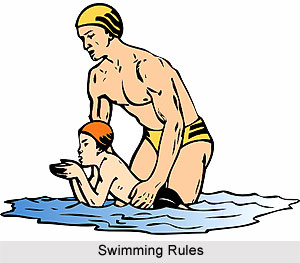 Basic rules of swimming dictate the game at competitive levels. The rules form as the guideline for the players. Following are the specifications of a swimming pool for Olympic Games:
Basic rules of swimming dictate the game at competitive levels. The rules form as the guideline for the players. Following are the specifications of a swimming pool for Olympic Games:
(a) Length: 50 m.
(b) Width: 21 m minimum with two spaces for each of 50 cm between the outside lane and the bath side walls. Lane width 2.5 m, total 8 lanes.
(c) Depth: 1.8 m overall which allows water polo matches to be played in the same bath.
(d) Floats on lane ropes: Circumference 0.05 to 0.11 m.
(e) Lane markings of a contrasting dark colour are set on the floor of the pool in the centre of each lane to guide competitors.
(g) Starting platform: It may be from 0.5 to 0.75 m above the surface of water. The surface area of each platform must be 0.5 x 0.5 m with a maximum slope of not more than 10. Surface of each block must be covered with non slip material with back stroke hand grip facility.
Dress
Men have to wear swimming trunks and women one-piece non-transparent swimming trunks with no open work except at the back. Caps and goggles may be worn, if desired.
Competition Judges
The regulations for international competitions for judges are as follows:
(a) Referee
(b) Two starters
(c) Chief Time-keeper
(d) Three Time-keepers per lane
(e) Chief Judge
(j) Three finish judges per lane
(g) Inspector of turns (one at each end of the lane)
(h) Four stroke judges
(i) Recorder
(j) Clerk-of-course.
The referee has complete control of the races. He may even disqualify a competitor for a infringement. It is obligatory to use electronic equipment for time-keeping at the Olympic Games.
This article is a stub. You can enrich by adding more information to it. Send your Write Up to content@indianetzone.com




